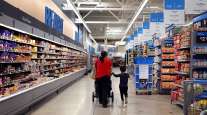Sanitation, Social Distancing Become New Normal in Trucking
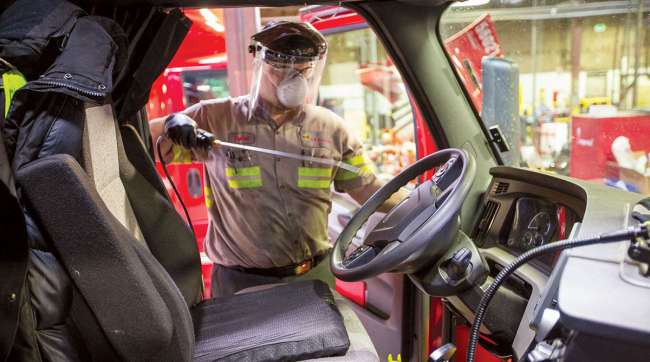
[Stay on top of transportation news: Get TTNews in your inbox.]
Truck drivers have been on the front lines of the nation’s response to the COVID-19 pandemic, and many of them have been heading into areas with high numbers of cases to deliver essential supplies.
To reduce the risk of contracting the virus while making these deliveries, drivers have been wearing personal protective equipment while regularly cleaning their cabs and adhering to social distancing guidelines.
However, many of the much-needed items such as masks, gloves and hand sanitizer have been in short supply, so fleets and drivers have had to innovate, and those who haven’t been able to find what they need have felt vulnerable.
►Essential Work, Truckers Rise to the Challenge
►Top 100 For-Hire Interactive Map
►How the Coronavirus Pandemic Might Reshape Trucking's Future
►Pandemic Exacts Heavy Financial Toll on Trucking Companies
Sector Rankings
LTL | TL/Dedicated
Intermodal/Drayage
Motor Vehicle/Driveaway
Tank/Bulk | Air/Expedited
Refrigerated | Flatbed/HS
Package/Courier | Mail
Household Goods/Commercial
Ingrid Brown, an owner-operator who has been traveling into some of the hardest-hit areas in New York to deliver food, said she had a hard time obtaining personal protective equipment.
“I feel like I’m running through a fire with gasoline britches on. I don’t have anything,” she said. “When I get back in my truck, I can’t wipe the steering wheel down. I have no masks, no gloves, no Clorox wipes, nothing.”
Deen Albert, director of operations at Grand Island Express, also said it has been difficult to find cleaning supplies and protective equipment.
“It is forcing us to think outside of the box,” he said.
The company was able to source concentrated cleaning products from a restaurant supplier, for example. Grand Island Express’ office staff even pitched in to make masks out of surplus T-shirts the carrier had in a storage room.
Those types of supplies have made Josh Rodriguez, a driver for the Grand Island, Neb.-based fleet, feel more comfortable when heading into areas in the Northeast hit hard by the virus. He wears gloves and a cloth mask and keeps hand sanitizer and sterilizing spray in the truck.
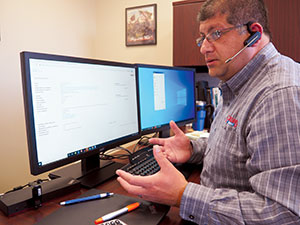
Deen Albert works around the clock to procure PPE for drivers and staff. (Grand Island Express)
“I feel as safe as I can in this situation with the interactions we have,” he said. “I don’t want to drive myself crazy, but I want to balance it with the proper precautions.”
David Allred, director of management services at C.R. England, said hand sanitizer has been in short supply, but the fleet has been able to find some and pass it out to drivers.
“We had to get creative, such as using a four-ounce restaurant squeeze bottle for hand sanitizer,” he said, adding that the company is also working to secure masks and gloves.
“However, since bulk orders have been back-ordered for some time, we still encourage all our employees to take the initiative to secure these items for themselves first, and the company will provide supplemental support,” Allred said.
Some drivers have relied on friends and family for help.
John Goode, a trainer and driver for C.R. England, said his aunt, who is a dentist, was able to pass along masks and gloves since her practice closed.
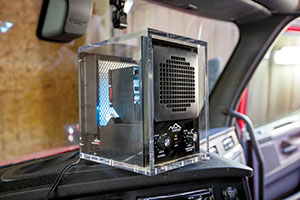
An air purifier sits in the cab of a C.R. England truck. (C.R. England)
“Every time we leave the truck, we put our surgical gloves on and put our mask on, and we don’t bring the gloves back in the truck with us,” Goode said. “After we do that, we sanitize our hands with the hand sanitizer, and we take the Clorox wipes and wipe down everything.”
C.R. England, based in Salt Lake City, ranks No. 26 on the Transport Topics Top 100 list of the largest for-hire carriers in North America.
Greer Woodruff, senior vice president of safety, security and driver personnel at J.B. Hunt Transport Services, said addressing the needs of 19,000 drivers in a short period was a challenge.
He said the company procured what it could locally and distributed 1.4 million gloves and more than 57,000 bottles of hand sanitizer in the early stages of the COVID-19 crisis.
J.B. Hunt, based in Lowell, Ark., ranks No.4 on TT’s Top 100 list of for-hire carriers,
In cases where supplies run low, fleets and drivers are finding alternatives.
If a driver can’t find hand sanitizer, for example, getting a gallon of water and a bar of soap can work as a backup, Woodruff said.
Rebekah Koon, a driver for Cargo Transporters, said her fleet has handed out hand sanitizer, but she carries soap and water on the truck as an added precaution.
Garner Trucking also is obtaining PPE for drivers but will reimburse them for any items they purchase on their own, said Tim Chrulski, operations director for the Findlay, Ohio-based fleet.
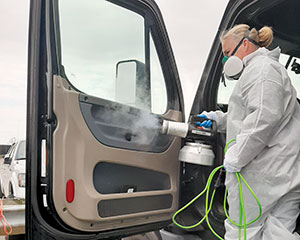
The cab of a Garner truck being disinfected by Dye of Details Auto Spa. (Garner Trucking)
Bill Woolsey, safety director for Freymiller, based in Oklahoma City, said distributing supplies to drivers has been tricky.
“Everyone is over the road and scattered, but as they have been able to come into the terminals, we’ve been able to provide supplies,” he said.
Quality Transport Co. also distributed kits to drivers and included visor cards with tips for staying safe. “We laminated those and put them in the kits as a quick reference guide,” said Amanda Schuier, senior vice president of Quality Transport, which is based in Freeport, Ill.
Drivers said they’re trying to pay attention to the little things that can reduce the risk of contracting COVID-19.
“I’m trying to be extra careful as to not touch my mouth, eyes or nose during these trying times,” said Sean Linton, an Averitt Express over-the-road driver based out of St. Louis. “I’m wiping out my truck more and using way more hand sanitizer, especially after touching bills of lading and pens at our customers.”
Cleaning Trucks and Offices
The Centers for Disease Control has emphasized the importance of sanitation in the fight against the novel coronavirus.
Wayne Spain, president of Averitt Express, said his company’s drivers are sanitizing their trucks before and after every shift.
“This involves wiping down the door handles, steering wheel, dashboard and other points of contact within the truck,” he said.
Averitt, based in Cookeville, Tenn., ranks No. 32 on TT’s for-hire Top 100.
Garner Trucking created a straightforward cleaning checklist for drivers and technicians to follow, which includes wiping down high-touch areas.
The fleet also is cleaning all high-touch items at its facility, including a fuel pump, on a daily basis.
“Those are some simple things we can all do to keep each other safe,” Chrulski said, adding that he has worked with an outside provider — Details Auto Spa — to disinfect equipment.
Crystal Dye, owner of Details Auto Spa in Findlay, Ohio, deep cleans the trucks using sanitizer and a fogger, which takes about an hour.
“You always hit those main areas where they are touching things,” she said. “I fog everything — underneath the seats, the drapes, the beds and the walls.”
Quality Transport is letting any empty trucks sit for two weeks and then conducting its standard cleaning procedure, Schuier said. She added that the company has made it mandatory for technicians to wear PPE when cleaning trucks.
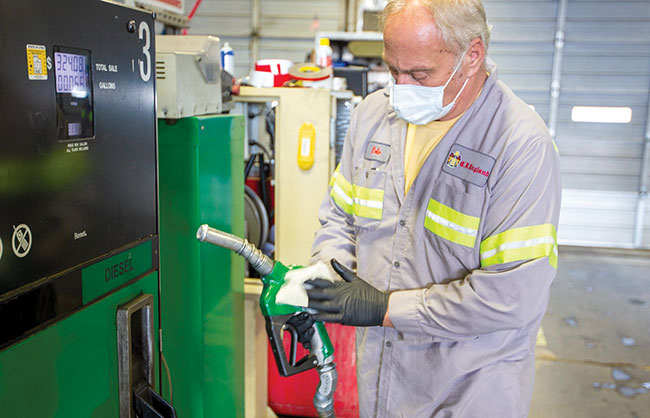
A C.R. England employee disinfects a gas pump as part of the company's sanitation measures. (C.R. England)
Doug Kading, vice president of maintenance for C.R. England, said the company has been using a powerful disinfectant to clean all the surfaces a technician touches while working on the equipment.
“Our mechanics are wearing gloves and safety glasses and have been issued face shields. All service writers and other driver-facing positions have face shields and gloves,” he said, adding that C.R. England has tractor cleaning companies provide extra surface wipedowns on each vehicle they clean.
At Grand Island Express, mechanics are wearing gloves and masks and sanitize the truck when they get in, as well as when they leave.
“We have enhanced communication with the driver, so the driver is well aware that the mechanic was in it and can wipe it down,” Albert said.
Fleets said they’ve stepped up cleaning at their offices and terminals as well.
One of the first steps Grand Island Express took was to separate the office staff and the drivers.
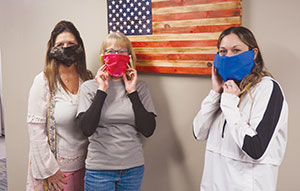
Employees at Grand Island Express with homemade masks. (Grand Island Express)
“That is counter to our culture, but it turned out to be a very necessary step,” Albert said, explaining that by limiting where drivers were going, the fleet could target where to sanitize.
The company has set up a regular schedule for cleaning doorknobs and surfaces.
C.R. England is wiping all high-contact areas with a hospital-grade disinfectant continuously.
“Office desks and common areas are cleared off each night so we can spray all areas nightly with the same disinfectant,” Allred said. “This includes floors, walls, chairs, restrooms, any areas you can imagine in all office buildings, shops and other company locations.”
C.R. England has brought in several additional custodians to wipe contact areas as well as continually monitor and fill hand soap, hand sanitizers and paper towels.
“These team members also spend several hours disinfecting areas with sprayers to ensure we minimize risk,” Allred said.
Averitt’s Spain said professional cleaners are frequently sanitizing the company’s offices. Desks, tables, door handles, keyboards and computer mouses are also wiped down regularly, Spain said.
Woolsey said Freymiller’s terminals have ramped up sanitation practices and is fogging the office after hours with a disinfectant.
Creating Distance
The CDC has recommended that people stay 6 feet apart to prevent the spread of COVID-19.
“Virtually every business we deal with on regularity has a procedure or policy in place to help their folks with social distancing,” said Chrulski of Garner Trucking, adding that he has had drivers contact him if they were uncomfortable with a situation.
“We were able to make some contacts with those customers and share concerns, and they were very quick to react to that or said they were already putting procedures in place,” he said.
Averitt Express requires all associates to practice social distancing at all times within its facilities and when on the road, Spain said.
“On the road, many shippers are not allowing drivers to access their docks. When they do have access to the dock and need to interact with a customer, they are keeping adequate space in between one another,” he said.
Averitt drivers shared several examples of social distancing at customer locations.
Robert Carrillo, a city LTL driver based in Chicago who regularly delivers to hospitals, said most of his customers don’t let him in the dock area.
“Shippers and receivers are doing their best to keep everyone separated,” said Chris Yohn, an over-the-road driver based out of Charlotte, N.C.
Social distancing measures are possible even when paperwork is involved.
“When it comes to paperwork, I’ll place the forms on a table for them to initial so that we can keep an appropriate distance from each other,” said Averitt’s Manny Rodriguez, a city LTL driver serving the McAllen, Texas, area.
Chrulski of Garner Trucking cited similar examples.
Some shippers don’t even want drivers to get out of the truck and will send someone out to meet them, while others have gone to a paperless bill-of-lading system, he said. “If this continues, you might gain some efficiency.”
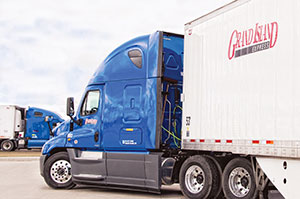
(Grand Island Express)
Grand Island Express driver Josh Rodriguez said many customers have been using tape to create squares or lines to facilitate 6 feet of separation.
“They’ve been enforcing that,” he said. “Before you’d be standing in line with eight to 10 drivers. Now there are no more than three inside, and the rest wait outside.”
C.R. England’s Goode said he tries to maintain space between his fellow team driver or trainee.
“Inside of the truck, we keep our masks on when we’re in the front seat or we separate ourselves, so one goes to the sleeper, and the other one stays here,” he said.
Fleets have embraced social distancing in the office environment as well.
Woolsey said Freymiller has more office space than it needs, so it has been able to spread out employees. The company also holds a limited number meetings and tries to determine if meetings are even necessary.
Even if Averitt’s associates are in the same building, meetings are taking place by phone and video teleconferencing, Spain said.
Garner Trucking stopped on-site sales calls to limit exposure, reduced staff in the office and transitioned the managers’ meeting to a video conference.
“We sent one person from each department home for each day for a week to make sure we had all of our pieces in place in terms of connectivity and their ability to do their jobs from home,” Chrulski said, adding that the fleet is taking temperatures of on-site workers each day.
C.R. England has implemented technology to enable nondriver employees to work from remote locations.
“For those still coming into the office, we have moved people around to give the needed social distancing as well as increased cleaning of all areas,” Allred said. “As in the driver facing areas, we are regularly spraying all work stations with a hospital-grade disinfectant to try and minimize any potential issues.”
Minimizing Stops
Drivers said they’re minimizing the places they visit on the road to try to avoid exposure.
Yohn is bringing food from home so he doesn’t have to go to a restaurant. Linton also said he is sure to carry food so he doesn’t have to go into truck stops for food or water.
Koon’s family put together packages of nonperishable foods for her.
“They brought it to the truck. I asked them to put it in front of the truck and move away,” she said. “I have a very strong support system in my fellow drivers and my family. Other truckers are not so fortunate.”
Want more news? Listen to today's daily briefing:
Subscribe: Apple Podcasts | Spotify | Amazon Alexa | Google Assistant | More




